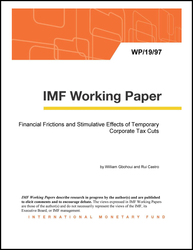
Financial Frictions and Stimulative Effects of Temporary Corporate Tax Cuts
This paper uses an industry equilibrium model where some firms are financially constrained to quantify the effects of a transitory corporate tax cut funded by a future tax increase on the U.S. economy. It finds that by increasing current cash-flows tax cuts alleviate financing frictions, hereby stimulating current investment. Per dollar of tax stimulus, aggregate investment increases by 26 cents on impact, and aggregate output by 3.5 cents. The average effect masks heterogeneity: multipliers are close to 1 for constrained firms, especially new entrants, and negative for larger and unconstrained firms. The output effects extend well past the period the policy is reversed, leading to a cumulative multiplier of 7.2 cents. Multipliers are significantly larger when controlling for the investment crowding-out effect among unconstrained firms.
Publication date: May 2019
ISBN: 9781498314244
$0.00
Add to Cart by clicking price of the language and format you'd like to purchase
Available Languages and Formats
| English |
Topics covered in this book
This title contains information about the following subjects.
Click on a subject if you would like to see other titles with the same subjects.
Corporate Tax Policy , Financing Frictions , Investment Dynamics , Fiscal Policy Multipliers , Firm Heterogeneity , , aggregate output , corporate tax , intertemporal , new entrant , corporate taxation
Summary
Copyright © 2010 - 2025
Powered by:
AIDC



